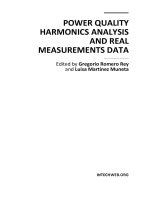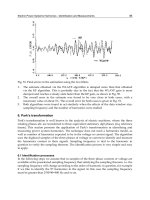Sensors, Focus on Tactile, Force and Stress Sensors 2011 Part 4 pdf
Bạn đang xem bản rút gọn của tài liệu. Xem và tải ngay bản đầy đủ của tài liệu tại đây (6.71 MB, 30 trang )
High-Sensitivity and High-Stiffness Force Sensor Using Strain-Deformation Expansion Mechanism
81
(28)
where ∗
X
and ∗
Y
denote the beams respectively along X-axis and Y -axis. Thereby, we can
know that there exist linear relations between an applied 3-axis force and the proposed
sensor’s strains.
According to eq. (28), the sensitivity and stiffness of the proposed sensing mechanism can be
regulated within a certain extent by the designing of the sensor’s dimensions and material.
C. Sensor’s sensitivity and expansion rate of sensitivity
This subsection discusses the expansion rate of sensitivity of the proposed sensing
mechanism for a certain applied force. For this purpose, the strain on the proposed sensor
will be compared with the strain on the beam which was employed for force sensing in
previous methods. In this paper, the sensitivity of joint torque sensor is defined as the
magnitude of the strain for sensing for every unit force.
At first, about the previous method which directl sticks gauges on the crossing beams, the
strains on beam ε
cz
and ε
cx
corresponding to forces F
z
and F
x
are represented as eqs. (1) and
(2) respectively. Accordingly, their sensitivity can be expressed as
(29)
(30)
On the other hand, the sensitivity of the proposed sensor can be written as
(31)
From eqs. (19), (21) and (29), (30),
/ε
c
will be
(32)
(33)
When
/ε
c
is larger than 1, sensitivity /F will be larger than ε
c
/F . In this paper, /ε
c
is
referred to as Expansion Rate of Sensitivity relative to a strain on beams.
Sensors, Focus on Tactile, Force and Stress Sensors
82
As the above discussion, by means of the proposed joint torque sensor, the applied force can
be sensed by “expanding” the strain-deformation on beams. The sensor will be referred to as
SDEM (Strain- Deformation Expansion Mechanism) Force Sensor hereafter.
4. Basic characteristics and implementation of SDEM force sensor
A. Experimental SDEM force sensor
Overview of a SDEM force sensor with size
φ
18 [mm]× 18 [mm] is shown in Fig. 6. The
dimensions about the proposed sensor is shown in Table I. The materials used for sensors
and beams are duralumin (A2014-T4) and austenitic stainless steel (SUS303) respectively.
According to eqs. (32) and (33), the expansion rate of sensitivity of the sensor are 3.071 in x
and y directions and 9.309 in z direction theoretically.
Table I. Dimensions of experimental force sensor
B. Evaluation of static characteristics
A series of forces in x (y) and z directions from −20.0 [N] to 20.0 [N], and forces continuously
and slowly changing in x (y) direction from 0 up to 6.2 [N] then down to −6.2 [N] and up to
0, in z direction from 0 up to 4.0 [N] then down to −4.0 [N] and up to 0 were respectively
applied on the SDEM force sensor to confirm the linearity and hysteresis characteristics.
Fig. 6. Experimental SDEM 3-axis force sensor
Fig. 7 shows the experiment results on the linearity of the sensor respectively in x (y) and z
directions, which plots the applied force values in abscissa and the SDEM sensor outputs in
ordinate. According to the errors which are less than ±0.004 [Nm], the degree of linearity
(100×error / measured range) is ±0.95 [%].
Based on the data from the SEDM force sensor and a Force Gauge (FGC-5N, made by Nihon
Densan), Fig. 8 gives the graphs plotting the hysteresis characteristics, which plots the Force
High-Sensitivity and High-Stiffness Force Sensor Using Strain-Deformation Expansion Mechanism
83
Gauge outputs in abscissa and the SDEM sensor outputs in ordinate. The hysteresis
differences in x (y) direction are less than 0.75 [N], those in z direction are less than 0.70 [N].
Fig. 7. Linearity between applied forces and sensor outputs
Fig. 8. Hysteresis characteristics
C. Evaluation of dynamic characteristics
The step response of the SDEM force sensor was examined. In the experiments of step
response, the applied forces in x (y) and z directions were varied respectively from 0.5 [kgf],
1.0 [kgf], 2.0 [kgf] to 0 instantaneously. The results are shown by Fig. 9, where almost no
overshoot or time lag appears.
D. Experimental verifications on expansion rate of sensitivity
In order to verify the expansion rate of sensitivity of the SDEM sensor experimentally, we
use a previous crossing beam sensor without the proposed sensing mechanism. In the
experiments, 3 forces of 0.5 [kgf], 1.0 [kgf] and 2.0 [kgf] were applied respectively in x (y)
and z directions, and the SDEM sensor outputs and the outputs from the previous sensor
were accumulated respectively. The 3 ratios of the two kind of outputs are plotted in Fig.
10.
According to the experimental results, the expansion rate of sensitivity of the SDEM
force sensor is 3.195 about x (y) direction, 9.429 about z direction on the average. On the
other hand, the expansion rate calculated theoretically is 3.079 about x (y) direction and
9.309 about z direction. The theoretical value and the experimental value are almost
equal.
Sensors, Focus on Tactile, Force and Stress Sensors
84
Fig. 9. Step responses
Fig. 10. Expansion rate of sensitivity
High-Sensitivity and High-Stiffness Force Sensor Using Strain-Deformation Expansion Mechanism
85
5. Conclusion
For dexterously performing object grasping and manipulation with multifingered hand of
robot, sensing the fingertip forces with high-sensitivity and highstiffness is desired. In
general, from previous sensing structures, if the stiffness of a sensor is made be high, its
sensitivity will be reduced, so that It is hard to realize the force sensing with both of high-
sensitivity and high-stiffness. This paper proposes a novel mechanism called Strain-
Deformation Expansion Mechanism for 3-axis force sensing. By the force sensing mechanism,
the small strain-deformation used for force sensing can be expanded while the sensor
stiffness will not be reduced but will be heightened. In this paper, the force sensing principle
was addressed by analyzing the deformation of the sensing mechanism and the forces
acting on the sensor theoretically. Then, the sensitivity of the sensing mechanism and its
expansion rate of sensitivity were defined, and a design method for realizing the sensing
mechanism with high sensitivity was discussed. Lastly, some experiments with robot finger
were performed to show the basic characteristics and the effectiveness of the proposed force
sensing mechanism.
The proposed force sensing mechanism can be also applied to other cases besides robot and
the like, for force sensing with high sensitivity and high stiffness.
6. References
L. E. Pfeffer, O. Khatib and J. Hake, “Joint Torque Sensory Feedback in Control of a
PUMA Manipulator,” IEEE Trans. on Robotics and Automation, Vol.5, No.4, pp.537-
544, 1989.
H. Asada et al., “Joint Torque Measurement of a Direct-Drive Arm,” Proc. of IEEE Int. Conf.
on Decision and Control, pp.1332, 1984.
D. Vischer and O. Khatib, “Design and Development of High-Performance Torque-
Controlled Joints,” IEEE Trans. on Robotics and Automation, Vol.11, No.4, pp.537-544,
1995.
Y. F. Zhang and Y. Fan, “Robot Force Sensor Interaction with Environments,” IEEE Trans. on
Robotics and Automation, Vol.7, No.1, pp.156-164, 1991.
U. Uchiyama, E. Bayo and E. Palma-Villalon, “A Mathematical Approach to the Optimal
Structural Design of a Robot Force Sensor,” Proc. of USA-JAPAN Symposium on
Flexible Automation, Vol.1, pp.539-546, 1988.
M. Kaneko and T. Nishihara, “Basic Study of Six-Axis Force Sensor Design Based on
Combination Theory,” Journal of the Robotics Society of Japan, Vol.11, No.8, pp.1261-
1271, 1993. (in Japanese)
K. Nagai, Y. Ito, M. Yazaki, K Higuchi and S. Abe, “Development of a Small Six-Component
Force/Torque Sensor Based on the Double-Cross Structure,” Journal of the Robotics
Society of Japan, Vol.22, No.3, pp.361-368, 2004. (in Japanese)
Y. Yu, T. Ishitsuka and S. Tsujio, “Torque Sensing of Finger Joint Using Strain-Deformation
Expansion Mechanism,” Proc. of IEEE Int. Conf. on Robotics and Automation, Vol.2,
pp.1850-1856, 2003.
Sensors, Focus on Tactile, Force and Stress Sensors
86
M. Meng, Z. Wu, Y. Yu, Y. Ge and Y. Ge, “Design and Characterization of a Six-axis
Accelerometer,” Proc. of IEEE Int. Conf. on Robotics and Automation, Vol.3, pp.2367-
2372, 2005.
Y. Yu, T. Arima and S. Tsujio, “Estimation of Object Inertia Parameters on Robot Pushing
Operation,” Proc. of IEEE Int. Conf. on Robotics and Automation, Vol.2, pp.1669-1674,
2005.
6
High-Precision Three-Axis Force Sensor for
Five-Fingered Haptic Interface
Takahiro Endo
1
, Haruhisa Kawasaki
1
, Kazumi Kouketsu
2
and Tetsuya Mouri
1
1
Gifu University
2
Tec Gihan Co. LTD
Japan
1. Introduction
Haptic interfaces that present force and tactile feeling have been utilized in the areas of
telemanipulation (Ivanisevi & Lumelsky, 2000; Elhajj et al., 2001), interaction with
micro/nano scale phenomena (Ando et al., 2001; Marliere et al., 2004), medical training and
evaluation (Langrana et al., 1994; Basdogan et al., 2001), and so on. Haptic interfaces are key
devices in constructing virtual reality environments. In contrast with single-point haptic
interfaces, multi-fingered haptic interfaces hold promise for the above-mentioned
applications and should dramatically increase the believability of the haptic experience
(Magnenat-Thalmann & Bonanni, 2006). From these points of view, several multi-fingered
haptic interfaces (Kawasaki & Hayashi, 1993; Ueda & Maeno, 2004; Walairacht et al., 2001;
Bouzit et al., 2002; Adachi et al., 2002; Yoshikawa & Nagara, 2000; Immersion Corporation)
have been developed.
A haptic interface consisting of an arm and fingertips (Adachi et al., 2002; Yoshikawa &
Nagara, 2000; Immersion Corporation) can be used in a wide space. However, most of them
consist of a hand and arm exoskeleton system. With this system, it is hard to represent the
weight of virtual objects through the fingertips because the hand mechanism is mounted on
the back of a human hand. Fixing the haptic interface to the hand binds the hand and creates
an oppressive sensation in the operator. Moreover, the operator is subject to a strong sense
of unease when the system performs abnormally. The haptic interface must be safe, function
in a wide space, and represent not only the force at the contact points but also the weight of
virtual objects. In addition, it should not cause an oppressive feeling when it attached to
humans and should not represent its own weight. In order to solve these problems, we have
developed a multi-fingered haptic interface robot, which is placed opposite to the human
hand: HIRO (Kawasaki et al., 2003) and HIRO II
+
(Kawasaki & Mouri, 2007). However,
HIRO and HIRO II
+
have high reduction mechanisms at all finger joints, an arrangement
that ensures the compactness of the mechanism, but requires force sensors at the haptic
fingertips.
Most haptic devices have a low reduction ratio, which permits impedance control without
the use of a force sensor. However, this requires a large mechanism and entails difficulty in
construction. Therefore, HIRO and HIRO II
+
have high reduction mechanisms and require a
Sensors, Focus on Tactile, Force and Stress Sensors
88
force sensor at each haptic fingertip. And, to accomplish high-precision force presentation to
the operator, they require high-precision force sensors. From this point of view, we have
developed high-precision three-axis force sensors and a compact sensor amplifier circuit
with 15 channels. The developed force sensor uses strain gauges, and its diameter and
length are 14 [mm] and 27 [mm], respectively. The size of the force sensor is small enough to
install at the haptic fingertip. The force sensor signals are inputted to an interface FPGA
circuit through a sensor amplifier circuit with a 24-bit A/D converter, which is mounted on
the back side of the haptic hand and communicates to a main control PC with LAN.
Therefore, high-precision force control was achieved while the number of wires in the
control system was minimized.
This paper presents the design and specifications of a newly developed three-axis force
sensor for the five-fingered haptic interface robot HIRO II
+
. The paper is organized as
follows: In the next section, the mechanical design of HIRO II
+
used here is summarized,
and the newly developed control system for HIRO II
+
is presented. In section 3, the design
and specifications of the developed force sensor are presented, and then we consider the
experiments of HIRO II
+
with the developed force sensor and control system in section 4.
The experimental results in free space and constraint space demonstrate the high potential
of the five-fingered haptic interface robot equipped with the developed three-axis force
sensors. Finally, section 5 presents our conclusions.
2. Five-fingered haptic interface
The authors have developed a five-fingered haptic interface, HIRO II
+
, consisting of a robot
arm and a five-fingered haptic hand as shown in Fig. 1. HIRO II
+
can present force and
tactile feeling at the five fingertips of the human hand. First we introduce HIRO II
+
briefly in
subsection 2.1, and then we present the control system with the newly developed force
sensor’s amplifier circuit and interface FPGA circuit in subsection 2.2.
Fig. 1. Five-fingered Haptic Interface Robot: HIRO II
+
.
2.1 Mechanical design
Fig. 1 shows the five-fingered haptic interface HIRO II
+
where it is coupled to the five
fingers of an operator’s hand. The haptic interface consists of an interface arm, a haptic hand
with five haptic fingers, and a controller. When the operator moves his/her hand, the haptic
interface follows the motion of the operator’s fingertips and presents the sensation of force.
High-Precision Three-Axis Force Sensor for Five-Fingered Haptic Interface
89
The operator feels only a small constriction because the only coupling between the human
hand and the haptic interface occurs through the fingertips of the operator. The features of
HIRO II
+
are the following: (a) HIRO II
+
can present force at the human five fingertips, (b)
HIRO II
+
can represent not only the force at the contact points but also the weight of virtual
objects, (c) HIRO II
+
should not cause an oppressive feeling when it is attached to humans
and does not represent its own weight.
Fig. 2. Interface Arm design.
Degree of freedom 6 [dof]
Output force 45 [N]
Output moment 2.6 [Nm] (max)
Translational
velocity
0.4 [m/s] (max)
Rotational velocity 1.4 [rad/s] (max)
Weight 6.9 [kgf]
Table 1. Specifications of the interface arm.
The interface arm is designed to be as close as possible to the human arm in geometry and
motion ability, as shown in Fig. 2. The lengths of the upper arm and the forearm are 0.3 and
0.31 [m], respectively. The arm joints are actuated by AC servomotors equipped with rotary
encoders and gear transmissions. The interface arm has 2 DOF at the shoulder joint, 1 DOF
at the elbow joint, and 3 DOF at the wrist joint. The interface arm therefore has 6 joints
allowing 6 DOF. Virtual work using the haptic interface can comfortably take place on the
work space of a desktop. Table 1 shows the specifications of the interface arm.
The haptic hand starts from the wrist but does not include it, and ends at the fingertips. The
hand base and five haptic fingers from the haptic hand are configured as shown in Fig. 3.
The haptic fingers are designed to be similar to the human fingers in geometry and motion
ability. Table 2 shows the specifications of the haptic hand. Each finger has 3 joints, allowing
Sensors, Focus on Tactile, Force and Stress Sensors
90
3 DOF. The first joint, relative to the hand base, allows abduction/adduction. The second
joint and the third joint allow flexion/extension. All joints are driven by DC servomotors
with gear transmissions and rotary encoders. Another important issue in haptic finger
design is the installation of the force sensors. In order to read the finger loading forces, a 6-
axis force sensor (NANO sensor made by BL AUTOTEC, LTD.) in the second link of each
finger is installed, of which 3-axis outputs, namely x-, y-, and z-elements, are used. The
resolution of the force sensors F
x
, F
y
, and F
z
, are 32, 32, and 98 [mN], respectively. Here, F
x
,
F
y
, and F
z
, are the x-, y-, and z-element output of the force sensor, respectively. To
manipulate the haptic interface, the operator wears a finger holder on his/her fingertips as
shown in Fig. 4. The finger holder has a sphere which, attached to the permanent magnet at
the force sensor tip, forms a passive spherical joint. The role of the passive spherical joint
attached by permanent magnet is to adjust the differences between the human and haptic
fingers orientations and to ensure that the operator can remove his/her fingers from the
haptic interface if it malfunctions. The suction force created by the permanent magnet is 5
[N].
Fig. 3. Haptic hand design.
Number of fingers 5
Degree of freedom 15 [dof]
Hand
Weight 0.73 [kgf]
Degree of freedom 3 [dof]
Output force 3.5 [N ](max)
Velocity 0.23 [m/s] (max)
Finger
Weight 0.13 [kgf]
Table 2. Specifications of the haptic hand.
Fig. 4. Finger holder.
High-Precision Three-Axis Force Sensor for Five-Fingered Haptic Interface
91
Fig. 5. Control system of HIRO II
+
.
The control system of HIRO II
+
is shown in Fig. 5. The control system consists of a PC, a 12-
bit digital-to-analogue converter (D/A), a 16-bit up/down counter (CNT), a 12-bit analogue-
to-digital converter (A/D), digital input and output (DIO), a hand motor analogue power
amplifier and an arm motor PWM driver. The real-time operating system ART-Linux is
adopted to guarantee 1[ms] sampling time of the control.
2.2 Developed control system for haptic hand
Most haptic devices have a low reduction ratio, which permits impedance control without
the use of a force sensor. However, this requires a large mechanism and entails difficulty in
construction. The fact that the haptic finger of HIRO II
+
uses a DC servomotor with a high
reduction ratio ensures the compactness of the mechanism, but requires force sensors at the
haptic fingertips. In particular, in order to accomplish high-precision force presentation to
the operator, we need high-precision force sensors. On the other hand, in order to present
the force at the five human fingertips, 15 DC servomotors and 5 force sensors are installed in
the haptic hand of HIRO II
+
. Hence, the communication cable between the PC and haptic
hand consists of 32 wires for the 15 encoders, 30 wires for the 15 DC servomotors, and 45
wires for the 5 force sensors, for a total wire count of 107. These wires greatly obstruct
smooth movement of the haptic interface. Further, the amplifiers of the force sensors are
stored under the haptic interface. Although the size of each force sensor amplifier is not
large (each is 11×13×16 mm), many amplifiers are needed, and the total size becomes large.
In order to solve these problems, we have developed high-precision force sensors and a
compact sensor amplifier circuit with 15 channels. The force sensor signals are inputted to
an interface FPGA circuit through a 24-bit A/D converter, which is mounted on the back
side of the haptic hand and communicates to the main control PC with LAN. This leads to
high-precision force control and reducing the number of wires of the control system. Next,
we introduce the newly developed haptic hand control system, which consists of an
interface FPGA circuit and a compact sensor amplifier circuit.
Fig. 6 shows the newly developed haptic hand control system made up of an interface FPGA
circuit and a compact sensor amplifier circuit. The size of both circuits is 70×70 [mm], and
Sensors, Focus on Tactile, Force and Stress Sensors
92
we can install these circuits on the back side of the haptic hand. The sensor amplifier circuit
has a 24-bit A/D and 12-bit D/A converter. The five force sensors at the haptic fingertips are
connected to the sensor amplifier circuit, and the output signals of the amplifier circuit are
inputted to the interface FPGA circuit. The interface FPGA circuit and control PC are
connected by Ethernet, so we could reduce the number of wires between the haptic hand
and the control PC from 107 to 72: namely, 8 wires for Ethernet, 32 wires for the 15 encoders,
30 wires for the 15 DC servomotors and 2 wires for the power supply to the FPGA circuit.
Furthermore, the sensor amplifier circuit has 15 channels. Hence the five force sensors can
be covered by this one circuit. In the former system, we needed five amplifiers for the five
force sensors. Although the size of each amplifier is not large, when five amplifiers are
needed the total size becomes large: 190×105×150 [mm]. Therefore, by developing the sensor
amplifier circuit, we could also miniaturize the total size of the haptic interface system.
Fig. 6. Developed Control System.
Fig. 7. Interface FPGA circuit.
Fig. 7 shows the interface FPGA circuit, which has the following functions:
• Reading analogue voltages of the five force sensors
• Offset adjustment of voltages of the five force sensors
• Communication between the FPGA circuit and the control PC by UDP/IP
High-Precision Three-Axis Force Sensor for Five-Fingered Haptic Interface
93
Table 3 shows the interface FPGA circuit specifications. In the FPGA chip, the digital signals
of the force sensors from A/D are read, and FPGA sends these signals to the control PC each
time the PC sends the commands. Moreover, when the PC sends the offset adjustment
signals of the force sensors, FPGA sends digital signals corresponding to the offset
adjustment signals to the D/A in the sensor amplifier circuit. As a result, the reading of the
analogue voltages of the 5 force sensors and the offset adjustment of the voltages of the 5
force sensors are accomplished. The interface FPGA circuit is connected with the PC by
Ethernet. The communication is fulfilled by UDP/IP, and is a command-and-response type
communication. For the communication, we established several commands (Table 4).
Size 70×70×1.6 [mm]
Type Xilinx Corp., Spartan3E(XCS500E)
FPGA
Clock frequency 100 [MHz]
Communication 100Base-TX
Baud rate 100 [Mbps]
Ethernet
protocol UDP
Serial communication
specification
SPI (Serial Peripheral Interface)
Communication
to sensor circuit
Communication clock frequency 2 [MHz]
Table 3. Specifications of the interface FPGA circuit.
Commands Function
HiroHand_open_connection Open connection between PC and FPGA by UDP/IP
HiroHand_close_connection Close connection
HiroHand_force_offset Offset adjustment of the force sensor
HiroHand_get_force Measurement fingertips forces
Table 4. Examples of communication commands.
Fig. 8 shows the newly developed sensor amplifier circuit for the force sensors, and Table 5
shows the interface FPGA circuit specifications. The size of the circuits is 70×70×5 [mm], and
the number of channels is 15. We installed a differential amplifier and low-pass filter in the
amplifier output of the sensor amplifier circuit, and we gave 24-bit high resolution to the
A/D converter in the sensor amplifier circuit. Thus, we consider that high-precision force
Fig. 8. Sensor amplifier circuit.
Sensors, Focus on Tactile, Force and Stress Sensors
94
control, namely the reduction of the operational drag, is achieved. Further, we installed a 12
-bit D/A converter in the circuit because of the offset adjustment of the force sensors. The
interface FPGA circuit and the sensor amplifier circuit are mounted on the back side of the
haptic hand as shown in Fig. 9.
Fig. 9. Developed circuits installed in HIRO II
+
.
Channel number 15 (3ch×5)
bridge voltage 2.048 [v](all-channel common)
differential
amplifier
0~1.25~2.5 [V] with respect to the outputs of the force
sensor -500~0~500 [με]
Amplifier
output
low-pass filter 6 [dB/oct], Fc = 100 [Hz]
Type ADS1258 (Texas Instruments Inc)
resolution 24 [bit]
A/D
converter
channel 16 (we used 15ch)
Type AD5328 (Analog Devices Inc)
Adjustment By using 0~1.25~2.5[V], -500~0~500[με] can be adjustment.
Resolution 12 [bit]
D/A
converter
channel 16 (we used 15ch: 8ch×2)
Power supply DC 5[V](0.5[A]) and DC3.3[V](0.1[A])
Size W70×D70×H5 [mm]
Table 5. Specifications of the sensor amplifier circuit.
3. Three-axis force sensor
3.1 Design concept and specifications
The purpose of the developed force sensor is to measure the three-axis forces, F
x
, F
y
, and F
z
,
at the haptic fingertip. Unlike most haptic devices that have a low reduction ratio, HIRO II
+
uses a DC servomotor with a high reduction ratio. A high-precision force sensor is required
to accomplish high-precision force presentation. The force sensor is installed in the second
link of each haptic finger and is connected to the developed sensor amplifier circuit,
introduced in subsection 2.2. The size of the force sensor has to be small enough to install at
the haptic fingertip. We set the following development goals for the force sensor:
High-Precision Three-Axis Force Sensor for Five-Fingered Haptic Interface
95
• Low load F
x
= F
y
= F
z
=10 [mN] can be measured;
• The outside diameter is 14 [mm]; and
• The interference between each axis force in the sensor element is minimal.
Fig. 10 shows the newly developed three-axis force sensor, and Fig. 11 shows its
dimensional outline drawing. By using the strain gauge in the pressure port of the sensor
element, the force sensor measures the force from the deformation of the metal beam. The
force sensor with strain gauge has the following advantages:
• The sensor has better linearity;
• The sensor has a small effect of temperature change; and
• The force sensor is suitable for the measurement of dynamic phenomena because the
amount of the displacement is extremely small.
In order to accomplish the development goals, we need a sensor element that can measure
the three axes forces with accuracy in a tight space.
Fig. 10 Three-axis force sensor.
Fig. 11 The dimensional drawing of the force sensor.
Sensors, Focus on Tactile, Force and Stress Sensors
96
3.2 Sensor structure
Fig. 12 shows the sensor structure of the developed three-axis force sensor. For the acting
axis force, the strain gauges are installed at the surface of the spot where the stress of the
sensor element reaches a maximum, and the force is detected as the change in electrical
resistance. The total number of strain gauges is 16: x1~x4, y1~y4, and z1~z8. For the forces
in the X- and Y-directions, the bending strains of x1~x4 and y1~y4 are detected,
respectively. Further, the shear strains of z1~z8 are detected for the force in the Z-direction.
Fig. 13 shows the circuit of the strain gauges. For each pair of strain gauges which detect the
corresponding axis force, a Wheatstone bridge is applied. In order to simplify the wire
system, the power supply to the bridge circuits is common, and we set up 8: 2 wires for the
input (power supply to bridge) and 6 wires for the output (F
x
-output, F
y
-output, and F
z
-
output). The output of the circuit is expressed as the strain [×10
-6
], and the force is measured
by calibrating the relation between the load and the strain.
Fig. 12 Force sensor structure.
Fig. 13 Bridge circuit.
High-Precision Three-Axis Force Sensor for Five-Fingered Haptic Interface
97
3.3 Basic characteristics
Fig. 14 shows the three-axis forces of the force sensor. From the calibration tests, we could
obtain the relationship between the load and the strain in each axis direction as shown in
Figs. 15, 16, and 17. The basic characteristics of the developed three-axis force sensor are the
following: The rated load is 10 [N]. For the rated load, the rated outputs of the X-direction,
Y-direction, and Z-direction are εx=1300×10
-6
, εy=1300×10
-6
, and εz=350×10
-6
, respectively,
where ε* is the strain of the *-direction. Nonlinearity and hysteresis, which reflect the
performance of the force sensor, are about 0.3%RO (Rated Output). Therefore, it can be said
that the output strain is linear with respect to the load in each axis direction. Further, the
interference output between each axis force also has linearity. Hence, the acting force can be
derived by correcting the mutual interference. Table 6 shows the specifications of the
developed three-axis force sensor.
Fig. 14. Three axis forces. Fig. 15. Strain output w.r.t. the load in the +X
direction.
Fig. 16. Strain output w.r.t. the load in the +Y Fig. 17. Strain output w.r.t. the load in the +Z
direction. direction.
Sensors, Focus on Tactile, Force and Stress Sensors
98
Rated capacity 10 [N]
X-, Y-direction ±0.5 [mV/V] (±1000×10
-6
strain)
Rated output
Z-direction ±0.15 [mV/V] (±300×10
-6
strain)
Safe overload 200 [%]
Nonlinearity ≤ |1.0| [%RO]
Hysteresis ≤ |1.0| [%RO]
Repeatability ≤ 1.0 [%RO]
Safe temperature range 10~70 [˚C]
X-, Y-direction ±0.05 [%RO/˚C] Temperature
effect on zero
Z-direction ±0.10 [%RO/˚C]
X-, Y-direction ±0.05 [%RO/˚C] Temperature
effect on output
Z-direction ±0.10 [%RO/˚C]
input 48±5% [Ω]
X-, Y-output 120±5% [Ω]
Input-output
resistance
Z-output 240±5% [Ω]
Weight 14.7 [g]
Table 6. Specifications of the developed force sensor.
4. Experiment of haptic interface using three-axis force sensor
In order to evaluate the developed three-axis force sensor, including the compact sensor
amplifier circuit and the interface FPGA circuit, we carried out two kinds of experiments.
One was the manipulation of the haptic interface in free space, and the other was the
manipulation of the haptic interface in constraint space. In each experiment, we compared
the experimental results of HIRO II
+
with the developed force sensor and HIRO II
+
with the
former force sensor. Figs. 5 and 6 show the control system of the HIRO II
+
with the
developed force sensor and HIRO II
+
with the former force sensor, respectively. As the
control law of the haptic interface, we used the following redundant force control: The
control of the haptic hand is given by
{
}
)()()()(
3
0
21
tqKFdssFKtFKJt
fd
t
ee
T
−++=
∫
τ
(1)
where
15
R∈
τ
is a joint torque vector of each finger of the haptic hand,
1515×
∈ RJ
is a
kinematic Jacobian,
15
521
],,,[ RFFFF
TTTT
∈= "
is a force vector whose sub vector is the
force vector at the fingertip,
15
521
],,,[ RFFFF
TT
d
T
d
T
dd
∈= "
is the desired force,
FFF
de
−=
,
and
15
521
],,,[ Rqqqq
TTTT
f
∈= "
is a joint angle vector of the haptic finger. Further,
+
∈ RK
i
is the feedback gain matrix. On the other hand, the control of the interface arm is
given by
⎟
⎟
⎟
⎟
⎠
⎞
⎜
⎜
⎜
⎜
⎝
⎛
×−
+−+=
∑
∑
∫
=
=
k
i
dihbi
k
i
di
T
afa
t
eaeaa
Fpp
F
JtqKdssKtKt
1
1
3
0
21
)(
)()()()(
τττ
(2)
where
+
∈ RK
ai
is the feedback gain matrix,
T
aaafa
qqqq ],,,[
621
"=
is the joint angle
vector,
66×
∈ RJ
a
is a kinematic Jacobian,
3
Rp
i
∈
is the i-th fingertip position vector,
3
Rp
hb
∈
is the tip of the interface arm and
High-Precision Three-Axis Force Sensor for Five-Fingered Haptic Interface
99
⎟
⎟
⎟
⎟
⎠
⎞
⎜
⎜
⎜
⎜
⎝
⎛
−×−
−
=
∑
∑
=
=
5
1
5
1
)()(
)(
)(
i
idihbi
i
idi
T
ae
FFpp
FF
Jt
τ
is an equivalent joint torque to the offset forces
)(
idi
FF
−
at the five fingertips. Details of the
control law have been shown in (Kawasaki & Mouri, 2007). On the other hand, the control
PC uses a real-time OS (ART-Linux) to guarantee 1 [ms] sampling time, for the experiments.
4.1 Manipulation in free space
Fig. 18 shows the responses of HIRO II
+
with the developed force sensor in free space, and
Fig. 19 shows the responses of HIRO II
+
with the former force sensor in free space. In each
figure, (a) shows the responses of the five fingertip positions and (b) shows the responses of
the five fingertip forces. Note that we considered the following force error for the i-th
fingertip’s force error:
222
zyx
i
e
FFFF ++=
. In both cases, the five fingers of the operator
(a) fingertip positions (b) fingertip forces
Fig. 18. Responses of HIRO II
+
with developed force sensor in free space.
(a) fingertip positions (b) fingertip forces
Fig. 19. Responses of HIRO II
+
with former force sensor in free space.
are connected to the haptic interface, and the operator moved his five fingertips like
drawing triangle. In the experiment, we considered the manipulation of the haptic interface
Sensors, Focus on Tactile, Force and Stress Sensors
100
in free space. Hence, the desired forces at the five fingertips are set to zero. But, the
responses of the fingertip forces have a slight force error. In order to consider the force error
quantitatively, we considered the average force error. The average force errors of HIRO II
+
with the developed force sensor and HIRO II
+
with the former force sensor were 0.13 [N]
and 0.33 [N], respectively. The responses of HIRO II
+
with the developed force sensor in free
space were apparently improved. However, in contrast with the finger joints’ backlash and
the friction, those of the arm joints are large, and we have considered that a large part of the
above average force error 0.13 [N] was caused by the interface arm.
4.2 Manipulation in constrained space
Next, we considered the manipulation of the haptic interface in constraint space. In the
experiment, the five fingers of the operator are connected to the haptic interface, and the
operator moved his five fingertips like drawing triangle while grasping the cube in the VR
space as shown in Fig. 20.
Fig. 20. Experimental environment.
Fig. 21 shows the responses of HIRO II
+
with the developed force sensor in the constraint
space, and Fig. 22 shows the responses of HIRO II
+
with the former force sensor in the
constraint space. In each figure, (a) shows the responses of the five fingertip positions and
(a) fingertip positions (b) fingertip force errors
Fig. 21. Responses of HIRO II
+
with developed force sensor in constraint space.
High-Precision Three-Axis Force Sensor for Five-Fingered Haptic Interface
101
(a) fingertip positions (b) fingertip force errors
Fig. 22. Responses of HIRO II
+
with former force sensor in constraint space.
(b) shows the responses of the five fingertip force errors. The following equation was used
for the i-th fingertip’s force error:
222
)()()(
d
zz
d
yy
d
xx
i
e
FFFFFFF −+−+−=
. The
desired force at each finger was set to be
ii
d
i
xDKxF
+=
, where
i
x
is the penetration
depth of the i-th finger into the cube,
K
(=600[N/m]) is the stiffness of the cube, and
D
(=1.0×10-
4
[Ns/m]) is the damping coeeficient of the cube. The average force errors of
HIRO II
+
with the developed force sensor and HIRO II
+
with the former force sensor were
0.17 [N] and 0.28 [N], respectively. The responses of HIRO II
+
with the developed force
sensor in the constraint space were apparently improved. However the responses of the
fingertip forces have a slight force error.
We have considered that the resolution of the force sensors, characteristics of the motor
amplifiers, adjustments of the feedback gain in the control law, and the backlash and friction
in the mechanism are related to the existing slight force error. In this study, we mainly
considered the resolution of the force sensor. In order to develop a better haptic interface,
we must clarify the cause and plan to investigate these problems as challenges for the
future.
5. Conclusion
In this paper, we have developed a small size high-precision three-axis force sensor, a
compact sensor amplifier circuit with 24-bit high resolution, and an interface FPGA
circuit. These circuits are mounted on the back of the haptic hand, and the output signals
of the force sensors are input to the interface FPGA circuit, which communicate to the
main control PC with LAN. Therefore, we could reduce the number of wires in the control
system. Furthermore, we carried out an experimental test and confirmed the
improvement of the haptic interface. This experiment demonstrates the high potential of
the five-fingered haptic interface robot HIRO II
+
with the developed three-axis force
sensors. The next problem to be tackled is to investigate the cause of the force error and
based on those results, to improve HIRO II
+
further. This paper was supported by the
Ministry of Internal Affairs and Communications Strategic Information and
Communications R&D Promotion Programme (SCOPE) and by a JSPS Grant-in-Aid for
Scientific Research (B) (19360190).
Sensors, Focus on Tactile, Force and Stress Sensors
102
6. References
Adachi, Y.; Kumano, T.; Ikemoto, A.; Hattori, A. & Suzuki, N. (2002). Development of a
haptic device for multi fingers by macro-micro structure. (in Japanese) J. Robot. Soc.
Jpn., Vol.20, No.7, pp. 725-733
Ando, N.; Korondi, P, T & Hashimoto, H. (2001). Development of Micromanipulator and
Haptic Interface for Networked Micromanipulation. IEEE/ASME Trans. Mechatron.,
Vol.5, No.2, pp. 417-427
Basdogan, C.; Ho, C. & Srinivasan, M. (2001). Virtual Environments for Medical Training:
Graphical and Haptic Simulation of Laparoscopic Commom Bile Duct Exploration.
IEEE/ASME Trans. Mechatron., Vol.6, No.3, pp. 269-286
Bouzit, M.; Burdea, G.; Popescu, G. & Boian, R. (2002). The Rutgers Masster II - New Design
Force-Feed backGlove. IEEE/ASME Trans. Mechatron., Vol.7, No.2, pp. 256-263
Elhajj, I.; Xi, N; Fung; W.; Liu, Y; Li, W; Kaga, T & Fukuda, T. (2001). Haptic Information in
Internet-Based Teleoperation. IEEE/ASME Trans. Mechatron., Vol.6, No.4, pp. 295-
304
Immersion Corporation. CyberForce [Online]. Available:
Ivanisevic, I. & Lumelsky, V. (2000). Configuration Space as a Means for Augmenting
Human Performance in Teleoperation Tasks. IEEE Trans. Syst., Man Cybern. B,
Vol.30, No.3, pp. 471-484
Kawasaki, H. & Hayashi, T. (1993). Force Feedback Glove for Manipulation of Virtual
Objects. J. of Robotics and Mechatronics, Vol.5, No.1, pp. 79-84
Kawasaki, H. ; Takai, J. ; Tanaka, Y. ; Mrad, C. & Mouri, T. (2003). Control of multi-fingered
haptic interface opposite to human hand, Proceedings of IROS 2003, pp. 2707-2712,
Nevada, USA, October, 2003
Kawasaki, H. & Mouri, T. (2007). Design and control of five-fingered haptic interface
opposite to human hand. IEEE Trans. on Robotics, Vol.23, No.5, pp. 909-918
Langrana, N.; Burdea, G.; Lange, K.; Gomez, D. & Deshpande, S. (1994). Dynamic force
feedback in a virtual knee palpation. Artif. Intell. Med., Vol.6, pp. 321-333
Magnenat-Thalmann, N & Bonanni, U. (2006). Haptics in virtual reality and multimmedia.
IEEE Multimedia, Vol.13, No.3, pp. 6-11
Ueda, Y. & Maeno, T. (2004). Development of a Mouse-Shaped Haptic Device with Multiple
Finger Inputs, Proceedings of IROS 2004, pp. 2886-2891, Sendai, Japan, 2004
Walairacht, S.; Ishii, M.; Koike. Y. & Sato, M. (2001). Two-Handed Multi-Fingers String-
basesd Haptic Interface Device. IEICE Trans. On Information and Systems, E84D,
No.3, pp. 365-373
Yoshikawa, T. & Nagara, A. (2000). Development and control of touch and force display
devices for haptic interface, Proceedings of SYROCO 2000, pp. 427-432, Vienna,
Austria, September, 2000
7
Optical Three-axis Tactile Sensor for
Robotic Fingers
Masahiro Ohka
1
, Jumpei Takata
2
, Hiroaki Kobayashi
3
, Hirofumi Suzuki
4
,
Nobuyuki Morisawa
1
and Hanafiah Bin Yussof
1,5
1
Nagoya University,
2
Olympus, Co.,
3
Toyota Industry, Co.,
4
Honda, Co.,
5
Universiti Tehnologi MARA
1,2,3,4
Japan
5
Malaysia
1. Introduction
Tactile sensors capable of sensing normal and shearing force produced on a robotic finger
and an object are useful for fitting a dextrose hand that can be applied to tasks that require
human-like handling. Examples include such manufacturing tasks as assembly,
disassembly, inspection, and materials handing. Especially in the case of humanoid robots,
grasping slippery or flexible objects is required in living environments for human beings in
contrast to industrial robots that handle standardized objects in controlled environments.
Since the three-axis tactile sensor is effective in such cases, its importance will increase with
improvements in humanoid robots.
A hemispherical tactile sensor is developed for general-purpose use with our three-axis
tactile sensor that is mounted on the fingertips of a multi-fingered hand. The present three-
axis tactile sensor is comprised of an acrylic dome, a light source, an optical fiber scope, and
a CCD camera. The light emitted from the light source is directed onto the edge of the
hemispherical acrylic dome through optical fibers. The sensing elements are concentrically
arranged on the acrylic dome.
In the following sections, after conventional tactile sensors are summarized to compare the
present tactile sensor’s merits and demerits with conventional tactile sensors,’ the principle
of the three-axis tactile sensor is described. Then the basic sensing characteristics are
examined for evaluating the present tactile sensor. Not only normal and shearing force
sensing but also repeatability is examined in a series of experiments. Finally, surface
scanning and object manipulation with one finger are shown to verify the applicability of
the present tactile sensor to multi-fingered hands.
2. Short survey of tactile sensors
The importance of tactile sensors was first emphasized in 1982 by Harmon (Harmon, 1982).
In this paper, human hand-like properties were desired in addition to functions of
Sensors, Focus on Tactile, Force and Stress Sensors
104
distributed logic array. Based on questionnaires of robot engineers, he summarized such
specifications of tactile sensors as a 10 x 10 array size, 1 – 10 ms response time, a wide
dynamic range of 1:1000, linearity, and a skin-like surface.
So far, various tactile sensors have been developed on the basis of several physical
phenomena, such as the piezoresistance effect (Ohka, M. et al., 1994; Takeuchi et al., 1994),
the capacitance variation (Novak, J. L., 1989), the piezoelectric effect (Dario et al., 1984;
Bicchi et al., 1989; Howe & Cutkosky, 1993; Yamada & Cutkosky, 1994), the resistance
variation of conductive rubber (Raibert & Tanner, 1982; Shimojo & Ishikawa, 1990),
magnetic variation (Hackwood et al., 1983), and the optical effect(Mott et al., 1984; Tanie et
al., 1986; Nicholls, 1990; Maekawa, 1992; Borovac et al., 1996). However, even today,
multirole tactile sensors have not been developed since every tactile sensor has both merits
and demerits. For example, although semiconductor type tactile sensors utilizing the
piezoresistance effect possess good linearity and can internally incorporate data processing
functions with IC technology, they are fragile. Such fragility is fatal since tactile sensing
intrinsically requires contact between the finger surface and an object. While conductive
rubber-type tactile sensors possess such excellent characteristics as large detective area and
skin-like soft surface, they emit spontaneous noise generated by the chattering of carbon
particles distributed in the rubber medium and also have hysteresis.
Although optical effect type tactile sensors (hereafter, optical tactile sensor) possess several
defects as well, they can be easily produced using simple equipment and Charge Coupled
Device (CCD) cameras and image data processing, which are mature techniques. Thus we
developed an optical three-axis tactile sensor based on the principle of an optical uniaxial
tactile sensor comprised of an optical waveguide plate, made of transparent acrylic and
illuminated along its edge by a light source (Mott et al., 1984; Tanie et al., 1986; Nicholls,
1990; Maekawa, 1992). As shown in Fig. 1, the light directed into the plate remains within it
due to the total internal reflection generated because the plate is surrounded by air, which
has a lower refractive index than the plate. A rubber sheet featuring an array of conical
feelers is placed on the plate to maintain array surface contact. If an object contacts the back
of the rubber sheet and produces contact pressure, the feelers collapse, and at the points
where these feelers collapse, light is diffusely reflected out of the reverse surface of the plate.
The distribution of contact pressure is calculated from the bright areas viewed from the
plate’s reverse surface.
Fig. 1. Conventional optical tactile sensor
Optical Three-axis Tactile Sensor for Robotic Fingers
105
Improving the uniaxial tactile sensor to design a three-axis tactile sensor is possible. A new
sensing element for it has been developed based on previous investigations (Ohka et al.,
1995; Ohka et al., 2004a; Ohka et al., 2004b; Ohka et al., 2005c); it has a columnar feeler and
four conical feelers that maintain contact with the acrylic surface while the tip of the
columnar feeler touches an object. Normal and shearing forces applied to the columnar
feeler tip are calculated from the area-sum and area-difference for the contact areas,
respectively. An optical three-axis tactile sensor for micro robots was developed on the basis
of simplified structure with a miniaturization advantage (Ohka et al., 2005b). Using simple
rubber sheets having only a conical feeler array and an image processing technique, normal
and shearing forces are calculated from the integrated grayscale value and the movement of
its centroid, respectively. However, these three-axis tactile sensors can approach an object
surface within limited direction due to their flat surfaces.
3. Sensing principle of optical three-axis tactile sensor
3.1 Structure of the present optical tactile sensor
The flat surface type tactile sensor described in the previous section is improved to be a
hemispherical tactile sensor, which we intend to mount on the fingertips of a multi-fingered
hand, as shown in Fig. 2 (Ohka et al., 2005c; Ohka et al., 2006). The multi-fingered robotic
hand for general-purpose use in robotics that includes links, fingertips equipped with the
three-axis tactile sensor, and microactuators (YR-KA01-A000, Yasukawa). Each
microactuator consists of an AC servo motor, a harmonic drive, and an incremental encoder
and is particularly developed for multi-fingered hand applications.
Fig. 2. Rendering of a three fingered hand equipped with optical three-axis tactile sensors









